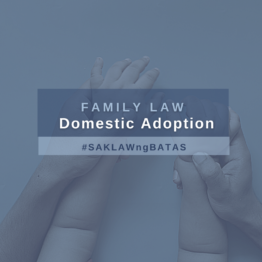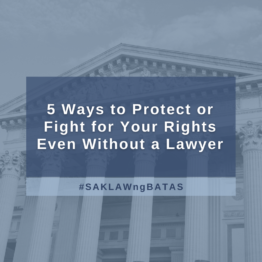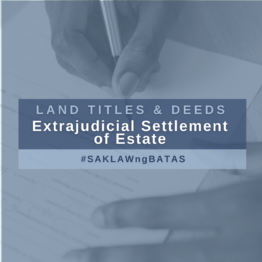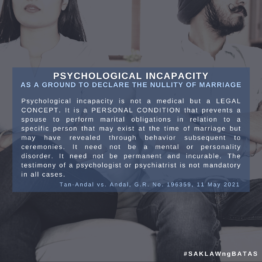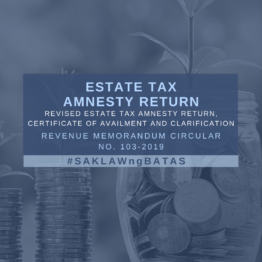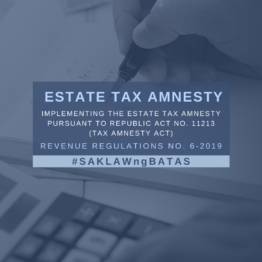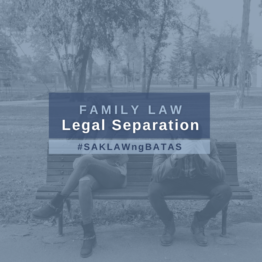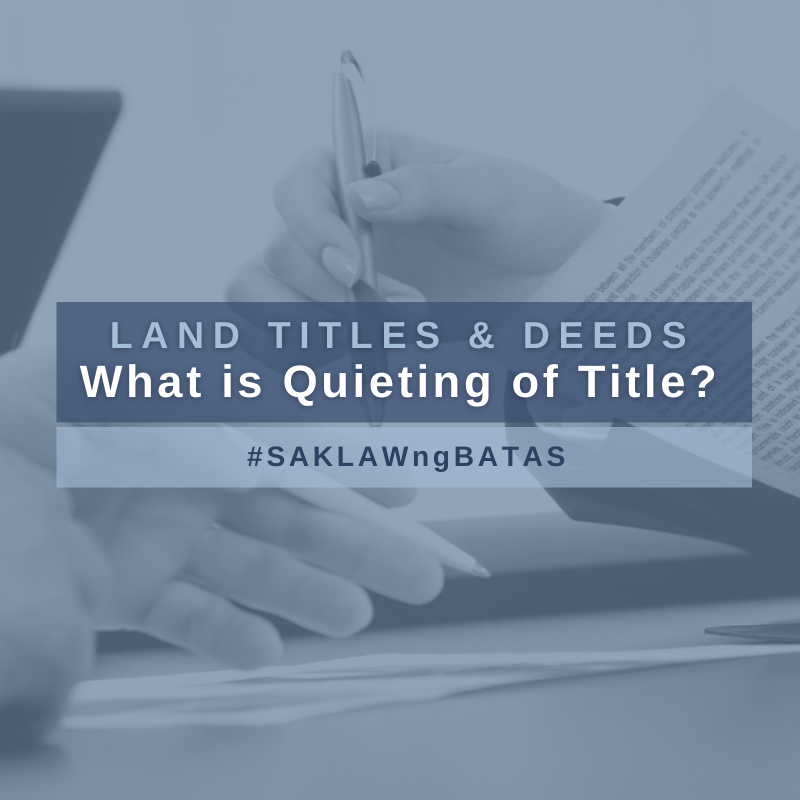
What is the legal basis for an action of quieting of title?
The remedy of quieting of title is governed by Article 476 and 477 of the Civil Code, which state:
“Art. 476. Whenever there is a cloud on title to real property or any interest therein, by reason of any instrument, record, claim, encumbrance or proceeding which is apparently valid or effective but is in truth and in fact invalid, ineffective, voidable, or unenforceable, and may be prejudicial to said title, an action may be brought to remove such cloud or to quiet the title.
An action may also be brought to prevent a cloud from being cast upon title to real property or any interest therein.
Art. 477. The plaintiff must have legal or equitable title to, or interest in the real property which is the subject-matter of the action. He need not be in possession of said property.”
What are the requisites of an action to quiet title?
An action to quiet title has two indispensable requisites, namely: “(1) the plaintiff or complainant has a legal or an equitable title to or interest in the real property subject of the action; and (2) the deed, claim, encumbrance or proceeding claimed to be casting cloud on his title must be shown to be in fact invalid or inoperative despite its prima facie appearance of validity or legal efficacy.” (Spouses Caldito v. Obado, G.R. No. 181596, January 30, 2017)
What is the the meaning of “title”?
The first requisite is based on Article 477 of the Civil Code which requires that the plaintiff must have legal or equitable title to, or interest in the real property which is the subject matter of the action. “Legal title denotes registered ownership, while equitable title means beneficial ownership, meaning a title derived through a valid contract or relation, and based on recognized equitable principles; the right in the party, to whom it belongs, to have the legal title transferred to him.” (Salvador v. Patricia, Inc., G.R. No. 195834, November 9, 2016)
What is the subject of an action for quieting of title?
The concept of a cause of action in ordinary civil actions does not apply to quieting of title. In declaratory relief, the subject-matter is a deed, will, contract or other written instrument, statute, executive order or regulation, or ordinance. The issue is the validity or construction of these documents. The relief sought is the declaration of the petitioner’s rights and duties thereunder. Being in the nature of declaratory relief, this special civil action presupposes that there has yet been no breach or violation of the instruments involved.
In an action for quieting of title, the subject matter is the title sought to have quieted. “Title” is not limited to the certificate of registration under the Torrens System (i.e., OCT or TCT). Pursuant to Article 477 of the Civil Code, the plaintiff must have legal or equitable title to, or interest in, the real property subject of the action for quieting of title. The plaintiff need not even be in possession of the property. (Republic v. Mangotara, G.R. Nos. 170375, 170505, 173355-56, 173401, 17356-64, 178779 & 178894, July 7, 2010)
When is there a “cloud on a title”?
“A cloud on a title exists when: (a) there is an instrument (deed, or contract) or record or claim or encumbrance or proceeding; (b) which is apparently valid or effective; (c) but is, in truth and in fact, invalid, ineffective, voidable, or unenforceable, or extinguished (or terminated) or barred by extinctive prescription; and (d) and may be prejudicial to the title.” (Heirs of Tappa v. Heirs of Bacud, G.R. No. 187633, April 4, 2016)
Who may file an action for quieting of title?
“Generally, the registered owner of a property is the proper party to bring an action to quiet title. However, it has been held that this remedy may also be availed of by a person other than the registered owner because, in [Article 476 of the Civil Code], ‘title’ does not necessarily refer to the original or transfer certificate of title. Thus, lack of an actual certificate of title to a property does not necessarily bar an action to quiet title.” (Spouses Portic v. Cristobal, G.R. No. 156171, April 22, 2005)
What is the prescriptive period for an action to quiet title?
“There is no prescription when in an action for reconveyance, the claimant is in actual possession of the property because this in effect is an action for quieting of title:
‘[S]ince if a person claiming to be the owner thereof is in actual possession of the property, as the defendants are in the instant case, the right to seek reconveyance, which in effect seeks to quiet title to the property, does not prescribe. The reason for this is that one who is in actual possession of a piece of land claiming to be the owner thereof may wait until his possession is disturbed or his title is attacked before taking steps to vindicate his right, the reason for the rule being, that his undisturbed possession gives him a continuing right to seek the aid of a court of equity to ascertain and determine the nature of the adverse claim of a third party and its effect on his own title, which right can be claimed only by one who is in possession.'” (Philippine National Bank v. Jumamoy, G.R. No. 169901, August 3, 2011, 670 PHIL 472-484)
Under what rule is an action for quieting of title filed?
An action for quieting of title is a special proceeding, specifically governed by Rule 63 of the Rules of Court on declaratory relief and similar remedies. Actions for declaratory relief and other similar remedies are distinguished from ordinary civil actions because in declaratory relief, the subject-matter is a deed, will, contract or other written instrument, statute, executive order or regulation, or ordinance. The issue is the validity or construction of these documents. The relief sought is the declaration of the petitioner’s rights and duties thereunder. (Republic v. Mangotara, G.R. Nos. 170375, 170505, 173355-56, 173401, 17356-64, 178779 & 178894, July 7, 2010)
“An action to quiet title or remove the clouds over the title is a special civil action governed by the second paragraph of Section 1, Rule 63 of the Rules of Court. Specifically, an action for quieting of title is essentially a common law remedy grounded on equity. The competent court is tasked to determine the respective rights of the complainant and other claimants, not only to put things in their proper place, to make the one who has no rights to said immovable respect and not disturb the other, but also for the benefit of both, so that he who has the right would see every cloud of doubt over the property dissipated, and he could afterwards without fear introduce the improvements he may desire, to use, and even to abuse the property as he deems best.” (Salvador v. Patricia, Inc., G.R. No. 195834, November 9, 2016)
How is an action to quiet title different from an action for reconveyance?
An action for reconveyance is based on Section 55 of Act No. 496, otherwise known as the Land Registration Act, as amended, which states “[t]hat in all cases of registration procured by fraud the owner may pursue all his legal and equitable remedies against the parties to such fraud, without prejudice, however, to the rights of any innocent holder for value of a certificate of title.” (Republic v. Mangotara, G.R. Nos. 170375, 170505, 173355-56, 173401, 17356-64, 178779 & 178894, July 7, 2010)
The concept of a cause of action in ordinary civil actions does not apply to declaratory relief as this special civil action presupposes that there has been no breach or violation of the instruments involved. Consequently, unlike other judgments, the judgment in an action for declaratory relief does not essentially entail any executional process as the only relief to be properly granted therein is a declaration of the rights and duties of the parties under the instrument, although some exceptions have been recognized under certain situations. (Republic v. Mangotara, G.R. Nos. 170375, 170505, 173355-56, 173401, 17356-64, 178779 & 178894, July 7, 2010)


